THE Water it is an abundant natural resource essential for the existence of life on Earth. Planet Earth is made up of an extensive mass of water, corresponding to what we know as the hydrosphere.
In addition to being present in the composition of the planet, water also makes up part of our body, allowing us to think that talking about water is talking about survival. this substance is used in activities essential to human beings, as agricultural production, and also used as a universal solvent.
The water was considered an inexhaustible resource. However, since it was considered a symbol of wealth, having been transformed into a commodity, it has also become synonymous with conflict. Misuse, waste, its distribution, as well as its occurrence are responsible for creating conflicts in different regions of the world. Concern about the availability of water is a frequent topic in environmental and geopolitical discussions.
Read too:Countries that have the least drinking water in the world
water on the planet
Planet Earth is flooded with water, forming the hydrosphere, comprising the oceans, seas and continental waters. About 71% of the Earth's surface is covered by water, totaling about 1.4 billion km3. It is considered the only planet that presents water in its three physical states: gaseous, liquid and solid. Of all the water available on the planet, 97.5% is salt water. Only 2.5% of the available water is fresh.
Watch:
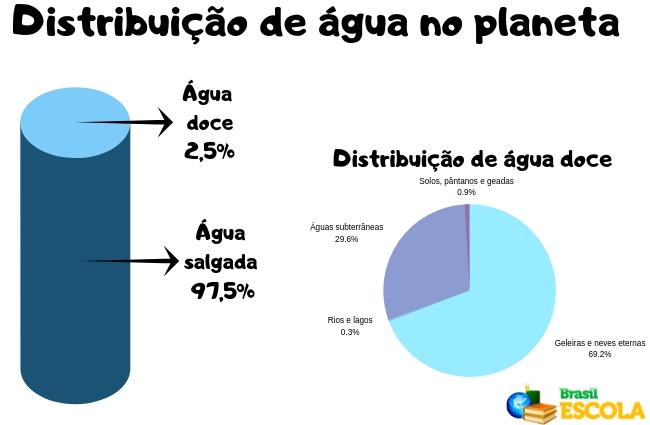
→ fresh water on the planet
The fresh water available on the planet it is not evenly distributed, varying according to the presence of ecosystems in different regions. Fresh water can be found in glaciers, eternal snow, groundwater, soils, rivers and lakes.
The countries that concentrate the most fresh water in the world are Russia, Brazil, Canada, United States, India, Colombia, Democratic Republic of Congo and China, corresponding to approximately 60% of the fresh water existing in the planet.
Do not stop now... There's more after the advertising ;)
According to data from the National Water Agency (ANA), the continent with the highest concentration of fresh water is America, with about 39.6%, followed by the Asian continent with 31.8%. The continent with the smallest volume of fresh water is Oceania, concentrating only 3.9% of available fresh water. Africa, due to its size, is one of the continents that suffers from lack of water, having in its territory about 9.7% of the world's fresh water.
Read more:World water distribution
Water in Brazil
Brazil is a country abundant in water resources, representing about 12% of the world total. However, its distribution is not uniform across the territory. According to ANA, fresh water is distributed in Brazilian regions as follows:
North region: corresponds to 68% of water resources;
Midwest region: corresponds to 16% of water resources;
South region: corresponds to 7% of water resources;
Southeast region: corresponds to 6% of water resources;
Northeast region: corresponds to 3% of water resources.
there is an visible contrast between water distribution in Brazil and population distribution. The North Region, which has the largest volume of fresh water in the country, is the region with the lowest population density, that is, it is one of the least populated regions, with only 7% of the population. The Southeast Region, the most populated in the country with about 42.63% of the population, has only 6% of the availability of water resources.
With regard to water waste, Brazil, according to the Ministry of the Environment, wastes between 20% and 60% of the water destined for consumption during distribution. The habits of Brazilians are also not conducive to saving water, as much of this substance is wasted either in personal use or in cleaning activities. To learn more, read:Water distribution in Brazil.
water cycle
O water cycle é responsible for the replacement of fresh water in the world and corresponds to the movement of water between the earth's surface and the atmosphere. Throughout the circulation, water presents itself in different physical states. The hydrological cycle takes place as follows:

Solar energy that reaches the earth's surface causes water in oceans, seas, lakes, rivers to evaporate. Water vapor rises to form clouds. Due to weather conditions, clouds can be loaded with moisture, which then precipitates in the form of rain, snow or hail. Upon returning to the surface, some of the precipitated water can evaporate even before reaching the ground; another part returns to the oceans, seas and other waterways; part of it infiltrates into the soil, supplying the underground reservoirs and thus the circulation process is restarted.
Potable water
Drinking water, according to the Ministry of Health, is "water that meets the standard of potability and does not pose a risk to health", that is, it is the one that can be consumed because it meets physical, chemical and biological requirements that establish its quality and ensure safety to consumer welfare.
The main requirements for classifying water as potable are:
be odorless, colorless and have an indefinable taste, but which allows it to be distinguished from other liquids;
it cannot contain pathogenic organisms, that is, that cause disease.
water use
Water, in addition to making up a large part of the planet and our body, ensuring the existence of life, also has numerous uses, being present in almost all human activities that allow the development of a society.
The activity that most consumes water in the world is the agriculture, according to the Food and Agriculture Organization of the United Nations (FAO). Almost 70% of water consumption is turned to the agricultural sector. The second activity that consumes the most fresh water is industry, according to the Ministry of the Environment, representing about 22% of consumption. Domestic supply corresponds to approximately 8% of consumption.
In Brazil, around 60% of the water consumed is destined for the agricultural sector; 17% to the industrial sector; and 9% to domestic supply.
readalso:Agricultural reuse water
The water issue: a global concern
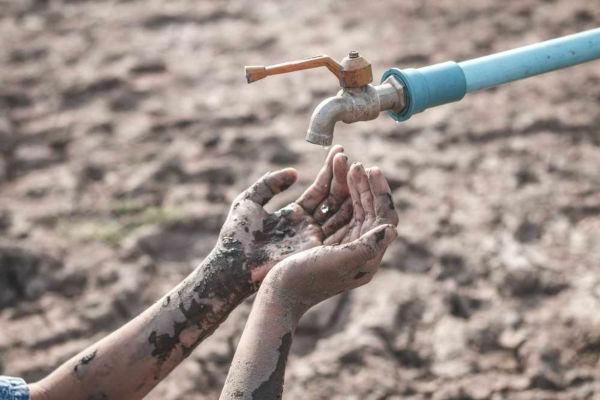
Water scarcity is a global problem that poses several challenges to society for the preservation of water resources.
Before, water was considered an inexhaustible resource. Today it is known that, due to several factors, such as the waste, a pollution, population growth, the climate changes, a urbanization and industrialization, water resources are becoming increasingly scarce, generating conflicts in different regions of the world. THE water issue and therefore, one of the most troubling discussions of the century.
According to the secretary general of the United Nations, António Guterres, more than 2 billion people worldwide do not have access to safe drinking water. The secretary also stated that, by 2050, at least one in four people will live in a country that will face a lack of drinking water. He warns of the inequalities found between developed and developing countries.
According to information released by the Environmental Company of the State of São Paulo (Cetesb), while in countries from Africa, which already suffer from the scarcity of water resources, a person uses between ten and fifteen liters of water per day. Water; in New York a person can use up to two thousand liters of water a day. Unesco data reveal that Cape Town, South Africa, may be the first to experience a total lack of potable water.
These organizations point to the huge need to rethink water consumption, waste and also to the need to promote actions that protect the water resources, pointing to sustainable uses, as well as the promotion of projects that review the water supply, sanitation and management systems.
readalso:Strategies to face the world's water crisis
Importance of water for the human body
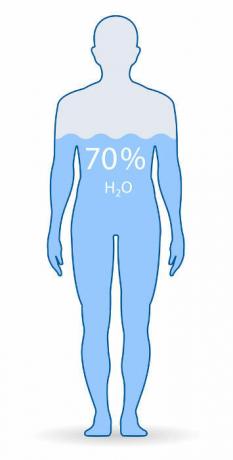
The human body is made up of about 60% to 75% water.
Water is essential for the functioning of the human body and also the bodies of other animals. To get an idea of the importance of this substance, we must first understand the composition of our body, which contains between 60% and 75% water. This large amount of water is essential for carrying out basic processes, such as:
Transport of nutrients to cells. This is due to the fact that water is one of the components of the blood plasma.
Regulation of our body temperature. At this point, the water acts by being part of the composition of the sweat, which when evaporating reduces our body temperature.
Fundamental for carrying out various chemical reactions that take place in our body.
It acts to protect our body. Water is present, for example, in joint fluids and amniotic fluid, which protect the fetus during development.
It acts at various points in the digestion process, being present, for example, in saliva.
Elimination of substances. Water is present in large amounts in the urine, which presents substances that are toxic or are in excess in our body.
Read too:Does cold water help you lose weight?
body water loss
Our bodies need water to carry out their activities, so there must always be a balance between the amount of water to be ingested and the adequate amount for the functioning of our body. Water balance is the difference between the amount of water that enters the body and that which is produced in metabolic reactions and the amount of water that is lost in the various processes of our body.
At water losses by the human body occur in several ways, highlighting the losses due to:
breathing;
urine;
feces;
sweat.
The greatest loss of water occurs through urine. Per day we eliminate between 1000 mL to 2000 mL of water from our body through this route. At feces, in turn, they represent a low loss of water, except in cases where the individual has diarrhea, and this problem is one of the causes of dehydration.
In addition, we have the loss for breathing, which is also considered low and the loss by the sweat, which will vary according to the activities performed by an individual and the temperature of the environment.
water in food
Water is present in the composition of various products, whether natural or industrialized. This means that we can get water not only by drinking it in the traditional way, but also by food intake. It is noteworthy that not all foods have the same amount of water in their composition, being observed foods with low water content and others with high percentages.
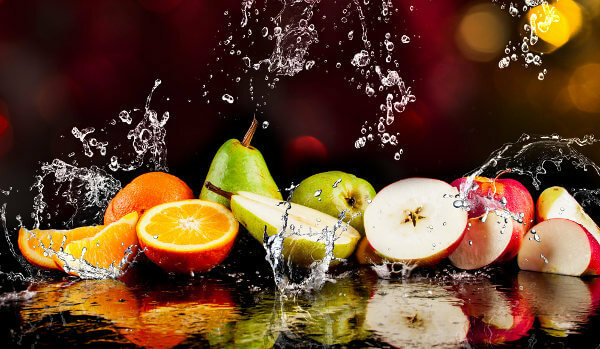
Some foods stand out for having a high water content.
Below is the percentage of water found in some foods.
Food |
Percentage of water (approximate value) |
Lettuce |
96% |
Cucumber |
95% |
Grape |
81% |
Apple |
84% |
Eggs |
75% |
Banana |
74% |
French fries |
44% |
Swiss cheese |
38% |
Butter |
16% |
fried cheese pastry |
17% |
French bread toast |
9% |
Cracker of water and salt |
3% |
Amount of water needed per day
We know that the recommendation of the Ministry of Health is to drink at least two liters of water each day. However, this amount is an average and varies according to some factors, such as the climate in which a person lives and the physical activities he or she performs. Thus, it is important to highlight that people who practice physical activities must consume more water due to sweating, as well as people who are exposed to high temperatures.
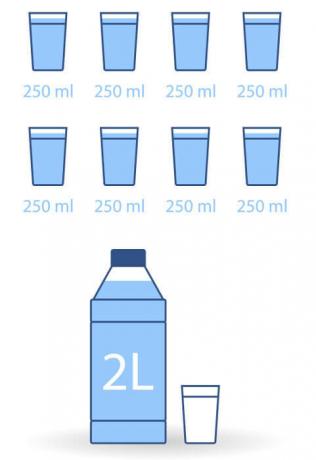
Many doctors recommend drinking at least two liters of water a day.
It is also worth noting that the recommendation for the amount of water varies according to the author we are analyzing. Some professionals suggest that to know the amount of water a person needs to ingest daily it is necessary multiply your weight by 35, this calculation being based on the idea that for each kilogram of mass a person needs to ingest 35 ml of water. Thus a person weighing 70 kg should drink 2450 ml or 2.45 liters of water.
By Rafaela Sousa (Graduated in Geography) and Ma. Vanessa Sardinha.
e) The large-scale diffusion and propagation of seawater desalination techniques are becoming important alternatives to combat the scarcity of this resource on the planet.
Water is a fundamental element for the development of life on our planet. For this element, check the correct alternative.
a) The planet's water is being compromised by domestic, industrial and agricultural pollution, in addition to environmental imbalances resulting from deforestation and misuse of the soil.
b) Water diversion for irrigation projects, construction of hydroelectric plants, excessive consumption, deforestation and pollution have contributed to the reduction of conflicts between users.
c) Water has been used to generate electricity, ensuring the sustainability of the local environment.
d) Brazil has little surface and underground water due to its dominant geological characteristics.
e) The decrease in rainfall in Brazil has been the biggest problem linked to the lack of water to supply cities.

